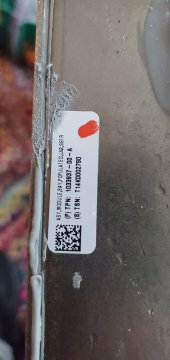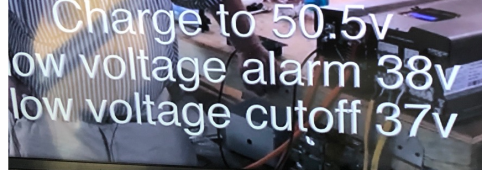You are using an out of date browser. It may not display this or other websites correctly.
You should upgrade or use an alternative browser.
You should upgrade or use an alternative browser.
What model tesla batt is this?
- Thread starter CamaroMan
- Start date
CamaroMan
New Member
- Joined
- Nov 26, 2022
- Messages
- 44
Also, these are my current settings in victron solar controller and bp220
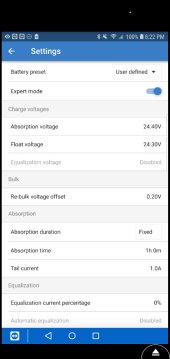
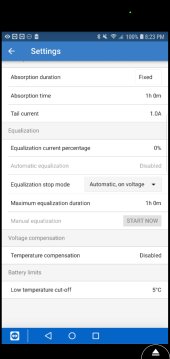
Bp220: currently no relay, probably set to alarm.. my inverter has an auto shut down at 21v as well, so I'm kinda stuck at this voltage so set it to the same on the bp220.. and yes my solar controller is not connected to the DC out but straight to the battery...
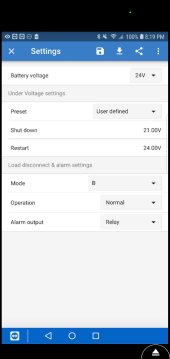


Bp220: currently no relay, probably set to alarm.. my inverter has an auto shut down at 21v as well, so I'm kinda stuck at this voltage so set it to the same on the bp220.. and yes my solar controller is not connected to the DC out but straight to the battery...

Attachments
It‘s your standard run of the mill Tesla module, more specifically:Hi busy researching bms for my tesla battery, not sure what model battery this is? Found an ebay match for model s/x 5.2kwh 250ah but wanted to be sure? Also possible to test capacity?
TESLA MODEL S X BATTERY 5.2KWH 24V 250AH MODULE SOLAR CELL LITHIUM ION
As found in the following:
2012-2020 TESLA S
2016-2020 TESLA X
CamaroMan
New Member
- Joined
- Nov 26, 2022
- Messages
- 44
It‘s your standard run of the mill Tesla module, more specifically:
TESLA MODEL S X BATTERY 5.2KWH 24V 250AH MODULE SOLAR CELL LITHIUM ION
As found in the following:
2012-2020 TESLA S
2016-2020 TESLA X
Thanks.. any thoughts or comments on the settings?
Thanks.. any thoughts or comments on the settings?
For liability reasons I will NOT endorse anyone's settings.. what I will do later today (I'm on conference calls all day) is post up some notes from my research and let you decide if your settings are correct.
I'll try to post later this afternoon.
Last edited:
Ampster
Renewable Energy Hobbyist
It is easy to do the math. Cobalt Lithium Chemistry tops out at 4.2 volts per cell so 4.1 would be conservative. Multiply that times number of parallel groups and that would be a number. What are your calculations?Thanks.. any thoughts or comments on the settings?
The key setting number is the Constant Voltage setting which is described in many different ways by devices. Bulk ending, Absorb, Boost are all used by various devices. Also, some of those modules are not necessarily the same capacity so make sure which one you have and if combining it with another make sure they are both the same capacity. Model S and X cars came in 60. 90 and 100 models which may have not even been the kWh capacity of the car.
Last edited:
CamaroMan
New Member
- Joined
- Nov 26, 2022
- Messages
- 44
For liability reasons I will NOT endorse anyone's settings.. what I will do later today (I'm on conference calls all day) is post up some notes from my research and own settings and let you decide if your settings are correct.
I'll try to post later this afternoon.
awesome thanks! pm also works -
The value of this board is that sharing on the forum allows EVERYONE to see it and get knowledge so I don't PM (as you've noticed by my not replying to your ones already sent), the value of the board is public knowledge, not PM shared knowledge.awesome thanks! pm also works -
Ampster
Renewable Energy Hobbyist
I agree. The exception is where personal information is being exchanged and for privacy reasons one prefers to keep that off the Internet.The value of this board is that sharing on the forum allows EVERYONE to see it and get knowledge
I don't consider system settings for a battery personal information which is what we're discussing, but yes, that's a given, I'm pretty familiar with it based on one of my certifications.I agree. The exception is where personal information is being exchanged and for privacy reasons one prefers to keep that off the Internet.
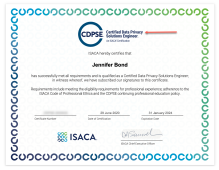
From my notes, where you see 48V mentioned, divide by 2 or 4 as your needs require. I may add more later but this should keep you busy for a day or so 
As you'll see, settings are across the board depending on an individuals system and comfort level as well as their intended usage, spike current levels anticipated etc, that's why it's not as easy as just asking someone what their settings are or what they think of yours.
@Will Prowse if you are not comfortable with Tesla settings being on the site I totally am ok with that, I know the history, please feel free to delete or modify.... totally ok by me.
---
Jack (EVTV) suggests low voltage cutoff at 38.65 in a 2 module pack in order to keep any excess voltage dips taking them too low. From video on YouTube dated aug 22 2018, "Rasberry PI Display for Tesla model s battery modules."
---
Read this page:
http://offgrid100.com/charging-a-tesla-module
---
Congressman Massie's Jack in the Box EVTV BMS settings (if you are not aware who he is, search on Youtube for his name and include tesla in your search and watch his 4 video series).
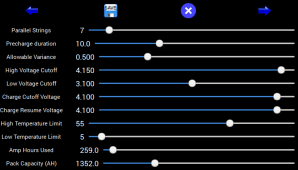
---
From: https://www.sigineer.com/product-ca...rs/tesla-battery-compatible-inverter-charger/
For our APC6048D, HP15048D , HP18048D 48Vdc models, that is
Low Battery Cut Off: 36Vdc
Low Battery Voltage Alarm/ Charger Activation: 37Vdc
Low Battery Cut Off Recovery: 47Vdc.
High Battery Voltage Alarm/ Charger Cut Off: 48Vdc
High Battery Cut Off: 51Vdc
For our APC6024D and APC6024DT 24Vdc model, that is
Low Battery Cut Off: 18Vdc
Low Battery Voltage Alarm/ Charger Activation: 18.5Vdc
Low Battery Cut Off Recovery: 23.5Vdc.
High Battery Voltage Alarm/ Charger Cut Off: 24Vdc (24.2vdc is 85% of module capacity rating). (Never charge to full voltage of 25.2vdc (4.2vdc per cell) charge to 24.1vdc which is 0%)
High Battery Cut Off: 25.5Vdc
For Sigineer Power’s M6048D and M12048D Tesla Battery Compatible Inverter, the powerful CPU allows users to set up their own spec for Tesla modules and other lithium batteries.
The recommended spec is:
Low Battery Cut Off: 36Vdc (36-48Vdc resettable)
Solar/Battery to Utility(DC to AC) transfer voltage: 44V ( 44-51.2Vdc resettable)
Utility to Solar/Battery(AC to DC) transfer voltage: 50V( 48-58Vdc resettable)
CV/Float voltage : 48V (48-58.4V resettable)
Warning: The output of the Tesla Battery Compatible Inverter will be de-rated by about 10% when the battery voltage drops below the nominal cut off of 20V, 40V, and 80V.
---
From a guy who's taking a single module and putting them in a new case and selling them, this is the sticker he puts on them:
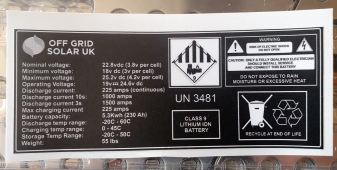
---
49v absorption
48.5 float
Max charge current 55amp from below video:
---
The MorningStar solar controllers are set for Absorption Volt = 24.1, Absorption Time = 12 Hours. This basically accomplishes that we hold the 24.1 Volt the whole day until the sun sets in the evening.
Our Magnum MS4024 is set for Absorption Volt = 24.2, Absorption Time = 4 Hours, and Float Volt = 24.0, but this charging is rarely used only when we exercise our generator.
I have MorningStar Solar Controllers that only have a regular 3 stage charger (Bulk, Absorption, and Float). The Tesla Modules should be charged with CC/CV (Constant Current/Constant Voltage). So to simulate that have I just changed the Absorption to 12 Hours. That means the sun will be gone before the controller try to do go to float.
I estimate the module to have 80% of the 5.3 kWh or 4.24 kWh. My average voltage with a straight line discharge assumption that is really close is 22.05 for my used range. Giving a 192 AH. But why use AH, it is only half of the picture and was invented by the 6 Volt Battery manufacturer to not compare apples to apples.
I have no catastrophic disconnect based on over-voltage and anything else.
From: http://offgrid100.com/charging-a-tesla-module/
---
From the Victron community pages:
Tom jubal48 · Sep 08 '19 at 7:27 PM
I think you may be misinformed. Victron updated the Victron Connect software last month to allow the Multiplus 24/3000 and Quatro 48/5000 to lower the low voltage start up from 21.8 volts to 20.6volts in the Multiplus 24/3000. This was done for us users of the Inverter/chargers with Tesla batteries to have a wider usable voltage range. The Multiplus firmware had nothing to do with this improvement. I am sure next week's firmware update for the Multiplus will be a bonus.
I can assure you I use the Multiplus 24/3000 50-70 with my Tesla battery bank. I have my low battery shut down set at 18.6 volts and my charge set at 24.4 volts. The Multiplus will function down to 18.6 volts unless you shut it down. The Multiplus will require a minimum voltage of 20.6 volts to power on. I have my BMS to open my contactor at 19 volts as I do not want to run down to 18.6 volts. The other option is to set the low voltage shut down at 19 volts, but then the low voltage restart will be set at 21 volts. If you should not have enough voltage to restart you can plug the Multiplus into shore power or generator power or solar power to get over the 20.6 volt threshold depending how you have your system set up.
This is the limitation of the inverter at this moment, but I don't think there is any other programable inverter/charger on the market that can do any better. Basically you lose some of the Tesla battery output but the Tesla is not much useful under 20 volts anyway and 19 volts should be your limit. I am not even sure there is a basic 24 volt 3000 watt inverter on the market that does not shut down below 20 volts.
If you require a wider operations range you would have to build a 18650 battery as a 7s or stick with a LiFePo4 chemistry found in the Victron Li Ion or Battle Born Batteries.
What will you be using for your BMS? REC.com makes one compatable with the Tesla and it can communicate with the Multiplus. A less expensive option is the Electrodacus SBMS0 or SBMS40 as both of these have automation for individual cell sensing for low voltage shut down, over charge protection shut down and low temperature control of charging. As well as cell balancing.
If you are not capable of setting up this type of BMS automation, then the use of the Victron Li Ion with BMS added electronics or the Battle Born may be a better choice as the BMS engineering is already worked out for you.
---
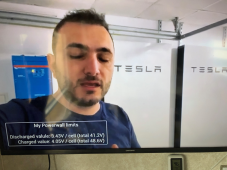
As you'll see, settings are across the board depending on an individuals system and comfort level as well as their intended usage, spike current levels anticipated etc, that's why it's not as easy as just asking someone what their settings are or what they think of yours.
@Will Prowse if you are not comfortable with Tesla settings being on the site I totally am ok with that, I know the history, please feel free to delete or modify.... totally ok by me.
---
Jack (EVTV) suggests low voltage cutoff at 38.65 in a 2 module pack in order to keep any excess voltage dips taking them too low. From video on YouTube dated aug 22 2018, "Rasberry PI Display for Tesla model s battery modules."
---
Read this page:
http://offgrid100.com/charging-a-tesla-module
---
Congressman Massie's Jack in the Box EVTV BMS settings (if you are not aware who he is, search on Youtube for his name and include tesla in your search and watch his 4 video series).

---
From: https://www.sigineer.com/product-ca...rs/tesla-battery-compatible-inverter-charger/
For our APC6048D, HP15048D , HP18048D 48Vdc models, that is
Low Battery Cut Off: 36Vdc
Low Battery Voltage Alarm/ Charger Activation: 37Vdc
Low Battery Cut Off Recovery: 47Vdc.
High Battery Voltage Alarm/ Charger Cut Off: 48Vdc
High Battery Cut Off: 51Vdc
For our APC6024D and APC6024DT 24Vdc model, that is
Low Battery Cut Off: 18Vdc
Low Battery Voltage Alarm/ Charger Activation: 18.5Vdc
Low Battery Cut Off Recovery: 23.5Vdc.
High Battery Voltage Alarm/ Charger Cut Off: 24Vdc (24.2vdc is 85% of module capacity rating). (Never charge to full voltage of 25.2vdc (4.2vdc per cell) charge to 24.1vdc which is 0%)
High Battery Cut Off: 25.5Vdc
For Sigineer Power’s M6048D and M12048D Tesla Battery Compatible Inverter, the powerful CPU allows users to set up their own spec for Tesla modules and other lithium batteries.
The recommended spec is:
Low Battery Cut Off: 36Vdc (36-48Vdc resettable)
Solar/Battery to Utility(DC to AC) transfer voltage: 44V ( 44-51.2Vdc resettable)
Utility to Solar/Battery(AC to DC) transfer voltage: 50V( 48-58Vdc resettable)
CV/Float voltage : 48V (48-58.4V resettable)
Warning: The output of the Tesla Battery Compatible Inverter will be de-rated by about 10% when the battery voltage drops below the nominal cut off of 20V, 40V, and 80V.
---
From a guy who's taking a single module and putting them in a new case and selling them, this is the sticker he puts on them:

---
49v absorption
48.5 float
Max charge current 55amp from below video:
The MorningStar solar controllers are set for Absorption Volt = 24.1, Absorption Time = 12 Hours. This basically accomplishes that we hold the 24.1 Volt the whole day until the sun sets in the evening.
Our Magnum MS4024 is set for Absorption Volt = 24.2, Absorption Time = 4 Hours, and Float Volt = 24.0, but this charging is rarely used only when we exercise our generator.
I have MorningStar Solar Controllers that only have a regular 3 stage charger (Bulk, Absorption, and Float). The Tesla Modules should be charged with CC/CV (Constant Current/Constant Voltage). So to simulate that have I just changed the Absorption to 12 Hours. That means the sun will be gone before the controller try to do go to float.
I estimate the module to have 80% of the 5.3 kWh or 4.24 kWh. My average voltage with a straight line discharge assumption that is really close is 22.05 for my used range. Giving a 192 AH. But why use AH, it is only half of the picture and was invented by the 6 Volt Battery manufacturer to not compare apples to apples.
I have no catastrophic disconnect based on over-voltage and anything else.
From: http://offgrid100.com/charging-a-tesla-module/
---
From the Victron community pages:
Tom jubal48 · Sep 08 '19 at 7:27 PM
I think you may be misinformed. Victron updated the Victron Connect software last month to allow the Multiplus 24/3000 and Quatro 48/5000 to lower the low voltage start up from 21.8 volts to 20.6volts in the Multiplus 24/3000. This was done for us users of the Inverter/chargers with Tesla batteries to have a wider usable voltage range. The Multiplus firmware had nothing to do with this improvement. I am sure next week's firmware update for the Multiplus will be a bonus.
I can assure you I use the Multiplus 24/3000 50-70 with my Tesla battery bank. I have my low battery shut down set at 18.6 volts and my charge set at 24.4 volts. The Multiplus will function down to 18.6 volts unless you shut it down. The Multiplus will require a minimum voltage of 20.6 volts to power on. I have my BMS to open my contactor at 19 volts as I do not want to run down to 18.6 volts. The other option is to set the low voltage shut down at 19 volts, but then the low voltage restart will be set at 21 volts. If you should not have enough voltage to restart you can plug the Multiplus into shore power or generator power or solar power to get over the 20.6 volt threshold depending how you have your system set up.
This is the limitation of the inverter at this moment, but I don't think there is any other programable inverter/charger on the market that can do any better. Basically you lose some of the Tesla battery output but the Tesla is not much useful under 20 volts anyway and 19 volts should be your limit. I am not even sure there is a basic 24 volt 3000 watt inverter on the market that does not shut down below 20 volts.
If you require a wider operations range you would have to build a 18650 battery as a 7s or stick with a LiFePo4 chemistry found in the Victron Li Ion or Battle Born Batteries.
What will you be using for your BMS? REC.com makes one compatable with the Tesla and it can communicate with the Multiplus. A less expensive option is the Electrodacus SBMS0 or SBMS40 as both of these have automation for individual cell sensing for low voltage shut down, over charge protection shut down and low temperature control of charging. As well as cell balancing.
If you are not capable of setting up this type of BMS automation, then the use of the Victron Li Ion with BMS added electronics or the Battle Born may be a better choice as the BMS engineering is already worked out for you.
---

Last edited:
@CamaroMan
PS: Please ensure you read @dougbert 's outstanding thread on how his system is setup, no cheating by just asking what his settings are, his thread is a wealth of information on contactors, inverters wiring safety etc.
PS: Please ensure you read @dougbert 's outstanding thread on how his system is setup, no cheating by just asking what his settings are, his thread is a wealth of information on contactors, inverters wiring safety etc.
Above notes are about 1/10th what I've saved over the last couple years and the biggest take away for you should be the importance of not rushing and doing your research BEFORE you go to sleep at night with one near you.
Trust me, a PMS'ing Tesla module's a LOT less fun to wake up next to than a PMS'ing girlfriend or wife, they usually limit the trauma to killing and cooking your pet bunny, not burning down your house... (I say usually, there are exceptions and thus why I stay single).
Trust me, a PMS'ing Tesla module's a LOT less fun to wake up next to than a PMS'ing girlfriend or wife, they usually limit the trauma to killing and cooking your pet bunny, not burning down your house... (I say usually, there are exceptions and thus why I stay single).
Similar threads
- Replies
- 5
- Views
- 442
- Replies
- 2
- Views
- 511
- Replies
- 6
- Views
- 1K



